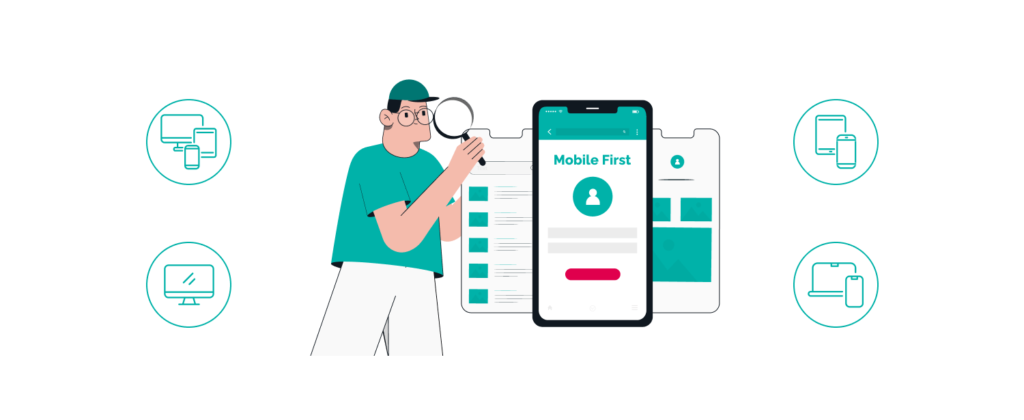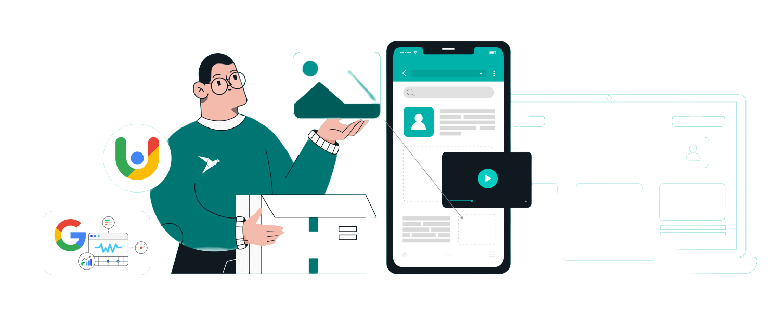Mobile-First Design is an approach to designing websites and mobile applications that prioritizes the needs and preferences of mobile users over desktop users. It involves designing the layout, content, and user experience of a website or app for small screens and low bandwidth, rather than scaling down from desktop versions.
Mobile devices are increasingly becoming the primary mode of accessing the internet. As a result, mobile app development has taken a central role in the world of web development. The demand for mobile apps is growing at an unprecedented rate, and developers are keen to create apps that offer the best user experience. In this blog post, we will explore the trend of mobile-first design and its best practices for developing mobile apps.
Understanding Mobile-First Design
Mobile-First Design is an approach to designing websites and mobile applications that prioritizes the needs and preferences of mobile users over desktop users. It involves designing the layout, content, and user experience of a website or app for small screens and low bandwidth, rather than scaling down from desktop versions.

Importance of Mobile-First Design in Mobile App Development
With the increasing popularity of mobile devices, mobile-first design has become crucial in mobile app development. It ensures that mobile users have a positive and engaging experience while using an app. It helps to improve engagement, user retention, and conversion rates, ultimately leading to higher revenue.
Key Principles of Mobile-First Design
The key principles of mobile-first design include simplicity, usability, and performance. The mobile-first design aims to create a simple and intuitive interface that is easy to use, without sacrificing functionality or performance.
Mobile-First Design Best Practices
-
Simplify Navigation and Layout
Mobile screens are smaller than desktop screens, so it’s important to simplify navigation and layout to make it easier for users to find what they are looking for. This can be achieved by using a clean and minimalist design, reducing the number of menus, and using large, easy-to-read fonts.
-
Use Responsive Design
Responsive design ensures that the website or app adapts to different screen sizes and resolutions. This is essential in mobile-first design, as it allows users to view content on their device without having to zoom in or scroll horizontally.
-
Optimize for Mobile Performance
Mobile users expect fast and responsive apps. To optimize performance, mobile-first design should focus on minimizing the use of large images and videos, reducing page load times, and optimizing code for mobile devices.
-
Design for Touch
Mobile devices use touchscreens, so it’s important to design for touch interactions. This means using large buttons, avoiding small links or menus that are difficult to tap, and incorporating gestures that are intuitive and easy to use.
Trends in Mobile-First Design
-
Dark Mode
Dark mode is a popular trend in mobile-first design that allows users to switch to a dark background, reducing eye strain and battery usage.
-
Voice User Interface
Voice user interface (VUI) is a trend that involves using voice commands to interact with mobile apps. This trend is becoming more popular with the increasing use of voice assistants like Siri and Alexa.
-
Augmented Reality
Augmented reality (AR) is a technology that overlays virtual objects in the real world. This trend is becoming more popular in mobile apps, particularly in gaming and retail.
-
Artificial Intelligence
Artificial intelligence (AI) is a trend that involves using machine learning algorithms to personalize user experiences and improve app functionality. This trend is becoming more popular in mobile apps, particularly in healthcare and financial services.
Benefits of Mobile-First Design
-
Improved User Experience
The mobile-first design ensures that the user experience is optimized for mobile devices, resulting in a more engaging and satisfying user experience.
-
Increased User Engagement
When a mobile app is designed with mobile-first principles, it is more likely to engage users, as it is tailored to their needs and preferences. This can lead to increased user engagement, which can translate into higher retention rates and increased revenue.
-
Better Conversion Rates
Mobile-first design can also improve conversion rates by making it easier for users to complete actions. Such as making purchases or filling out forms. By optimizing the user experience for mobile devices, businesses can increase the likelihood of users converting to customers.
Mobile-First Design Tools and Technologies
-
Mobile-First Frameworks
There are several mobile-first frameworks available that can help developers build mobile apps quickly and efficiently. Examples of popular frameworks include React Native, Flutter, and Ionic.
-
Prototyping Tools
Prototyping tools can help designers create interactive prototypes of their mobile app designs. Allowing them to test and iterate on their ideas before starting development. Examples of popular prototyping tools include Figma, Adobe XD, and Sketch.
-
Analytics Tools
Analytics tools can provide valuable insights into user behavior and help developers and designers optimize the user experience. Examples of popular analytics tools include Google Analytics, Mixpanel, and Flurry.
Challenges in Mobile-First Design
-
Device Fragmentation
One of the biggest challenges in mobile-first design is the wide range of devices and screen sizes that exist in the mobile landscape. Designers and developers must ensure that their mobile apps are optimized for a variety of devices and screen sizes.
-
Platform Limitations
Different mobile platforms have different limitations and requirements, which can make it difficult to design and develop mobile apps that work well across all platforms. Designers and developers must consider these limitations and requirements when designing and developing mobile apps.
-
User Expectations
Users have high expectations when it comes to mobile apps, and they expect them to be fast, easy to use, and visually appealing. Designers and developers must ensure that their mobile apps meet these expectations to be successful.
Future of Mobile-First Design
-
Continued Growth in Mobile App Development
Mobile app development is expected to continue to grow in the coming years, as more businesses recognize the importance of mobile apps in their overall strategy.
-
Emphasis on Personalization
Personalization is becoming increasingly important in mobile app design, as users expect mobile apps to be tailored to their individual needs and preferences.
-
Integration with Emerging Technologies
Emerging technologies such as artificial intelligence and machine learning are expected to play a larger role in mobile app design and development in the coming years. As designers and developers seek to create more intelligent and intuitive mobile apps.
Conclusion:
Mobile-First Design is the way of the future. As more and more users rely on their mobile devices for internet access, mobile apps need to be designed with the user in mind. By following the best practices outlined in this blog post, developers can create mobile apps that offer a seamless and enjoyable user experience. As mobile app development continues to grow, the importance of Mobile-First Design will only become more significant.
Stay ahead of the curve with Tanbits Mobile-First Design services! Our expert developers follow the latest trends and best practices to create mobile apps that prioritize the user experience, helping you stay competitive in the ever-evolving mobile landscape.











